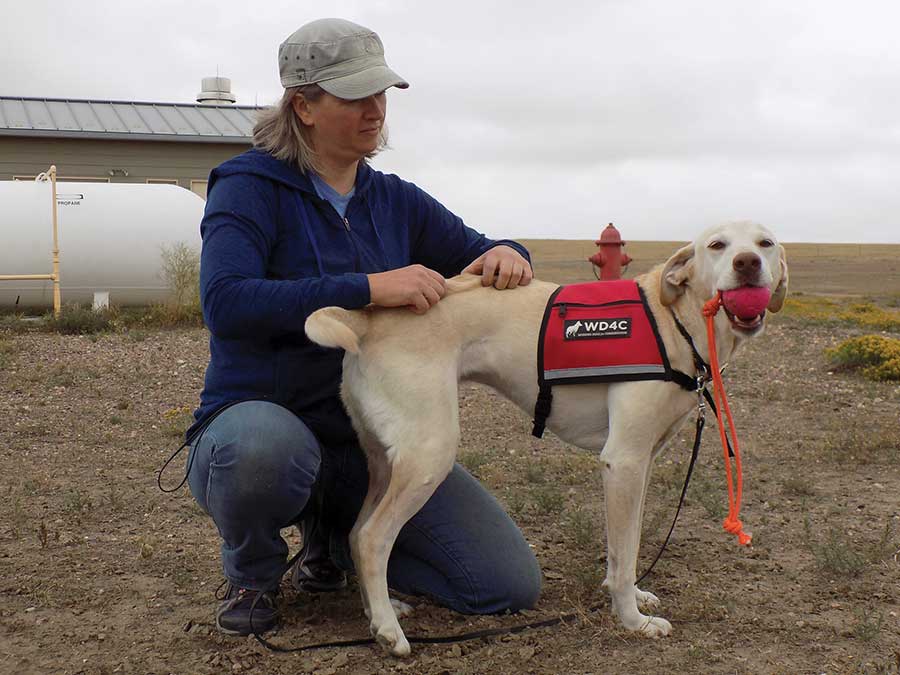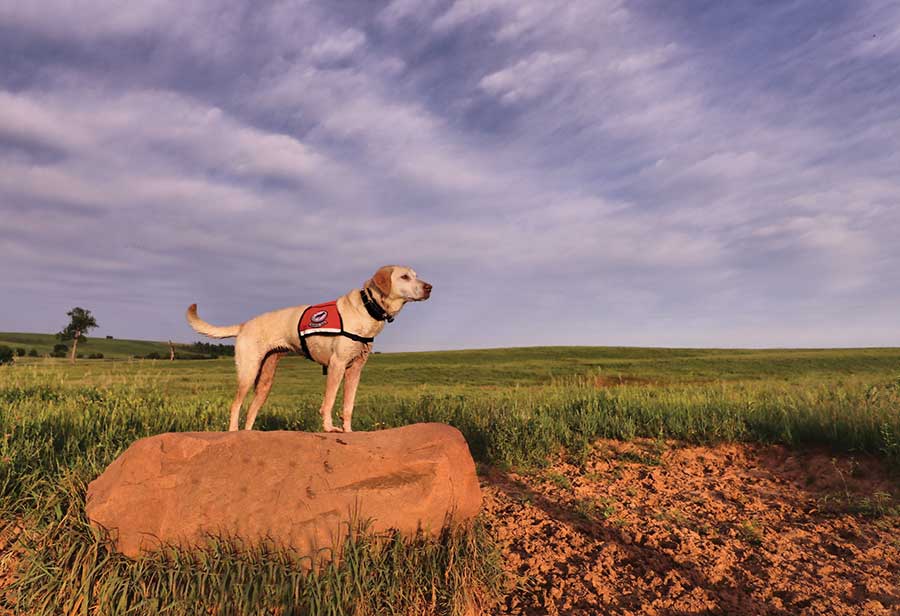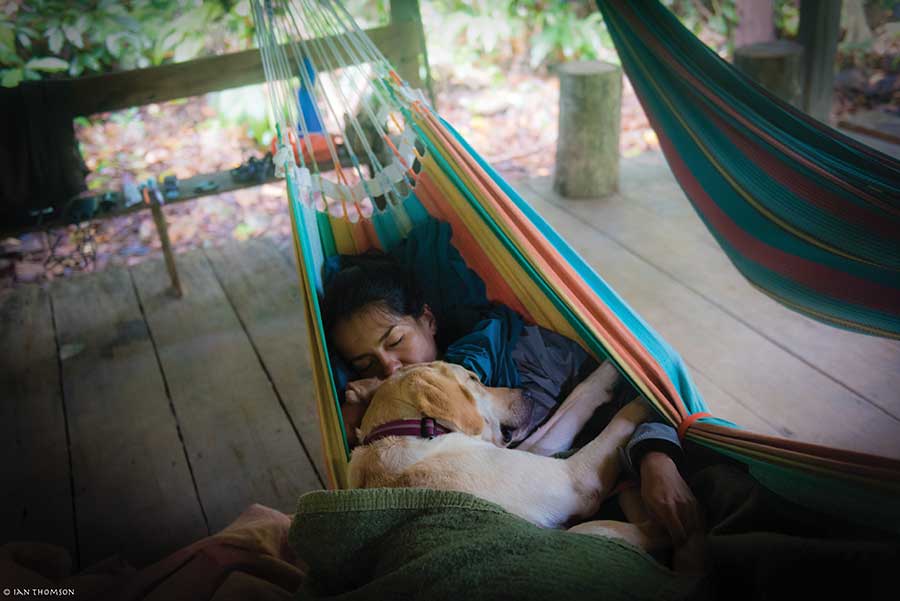Rescued Labs protect wildlife and wild places through Working Dogs for Conservation
[dropcap]B[/dropcap]y the time the yellow Lab named Lily was three years old, she’d already had five homes. The energetic girl was just too obsessed with the chance to play with a ball, spinning and barking until she got her toy.
Fortunately, the qualities that made Lily challenging to place with a family were perfect for Working Dogs for Conservation (WD4C), a nonprofit that rescues dogs and trains them to be conservation detection dogs. Using positive reinforcement techniques, trainers taught Lily to learn to detect 12 scents, including grizzly bear scat.
“The type of dog we’re looking for tends to end up in shelters because they’re incredibly intense dogs,” said Kayla Fratt, communications and outreach coordinator for WD4C. “These are the sort of Labs that were bred to spend eight hours a day hunting and retrieving in the field. They’re not what most people sign up for when they think they want the pet.”
That intensity has served Lily – and the environment – well. The 11-year-old Lab has tracked pumas through the mountains of Idaho and now searches for invasive plants on the prairie, which is less demanding on her aging joints. She also loves demonstrating her detection skills for crowds, and water therapy (like swimming) and acupuncture help keep her agile.
“Lily doesn’t know she’s eleven at all. She’s still wagging, and bouncy, and spins in circles, and barks at you,” Fratt said. “She’s a very, very happy girl.”
Since four female biologists founded Working Dogs for Conservation in 2000, dogs who don’t thrive in traditional homes have found success working to protect wildlife and the environment around the world. Dogs typically work for about four hours a day, with a day off every third day.
“We only ‘hire’ dogs that are crazy about this job,” Fratt said. “We make sure that they like it, and most of our dogs seem absolutely thrilled. They all really love the job. As soon as you pull out the training bag or the vest that they wear in the field, they’re jumping and barking and going crazy about trying to get to work; or, depending on the dog’s manners, they’re sitting and staring at you very intently and trying so hard to be polite.”
While some dogs are rescued from shelters, others are hired as “career change” dogs originally trained to be service dogs. For instance, a yellow Lab named Tigre started out training to be a service dog for injured veterans. But he was too obsessed with balls, even trying to bite them off the base of metal walkers.
Now, Tigre is stationed full-time in Costa Rica, where, as his name suggests, he helps detect wild cat samples, such as jaguar, puma, ocelot, oncilla, margay, and jaguarundi. He’s found more than 100 samples for the nonprofit Panthera, which works to preserve big cats and their ecosystems.
 Recently Tigre has been finding scat to help conservationists determine which jaguars are related and what their habits are, like how far young will travel from their parents. Deploying detection dogs like Tigre is an ideal alternative to relying on camera traps or having to trap big cats to get blood samples.
Recently Tigre has been finding scat to help conservationists determine which jaguars are related and what their habits are, like how far young will travel from their parents. Deploying detection dogs like Tigre is an ideal alternative to relying on camera traps or having to trap big cats to get blood samples.
There are still challenges to the work, of course. Fratt accompanied Tigre and his handler early in her career with WD4C.
“It’s a lot of really tough jungle travel,” she shared. “There’ll be one person walking in the front with a machete, keeping an eye out for snakes and trying to clear a path. We had monkeys throw branches at us. It’s quite the adventure.”
[dropcap]M[/dropcap]eanwhile, in Africa, a black Lab mix named Ruger works to help stop poachers in Zambia. Found as a stray in Montana, he was starting to go blind when WD4C brought him on board. Though he’s lost most of his vision, Ruger still excels at searching vehicles for ivory, rhino horn, firearms, bushmeat, and other illegal contraband. He’s had numerous successful busts since deploying in 2014.
“He’s an incredibly methodical worker who’s one of our best African detection dogs,” Fratt said.
WD4C dogs also protect wildlife at home. Fratt often works with Tobias, a yellow Lab – and former stray – who helped eradicate invasive Argentine ants from Channel Islands National Park in Southern California. More recently, he’s been helping detect scat of the endangered kit fox and searching boats at Yellowstone and Glacier National Parks and Lake Roosevelt National Recreation Area for invasive mussel species.
“He’s a ton of fun,” she said. “He’s all business when he’s working, but his tail is still going a million miles a minute.”
Fratt said conservation dogs are outstanding in their jobs because while humans search visually, dogs use their noses. After a crew pulls as many invasive plants as they can find, dogs will essentially double check their work – finding plants that may be hard to notice because they are small, have been trampled by cattle, or are growing inside another bush.
With scat, humans tend to look directly on a trail. But the dogs might run more than 20 meters off the trail if they catch a whiff of something.
“Unless you had a search line of people walking shoulder to shoulder, you were not very likely to have found it as a human searcher,” she said.
The dogs are also wonderful ambassadors for conservation work, she noted.

“Retired” from tracking mountain lions in Idaho, Lily now searches for invasive plants on the prairie.
“Not only are they great at the detection work, but they also attract crowds and get people interested and excited to learn more. We talked to over 750 people this last year about invasive species when we were in different national parks,” she said.
Working Dogs for Conservation finds potential conservation dogs through its sister organization, Rescues 2the Rescue. The best way to start the selection process for a candidate is to visit the website, review the selection criteria, and upload a video of the dog per specific instructions.
“If people know of a Lab or other breed in need of a home, and who is way too high energy and totally obsessed with balls, they can find our selection criteria at Rescues2theRescue.org,” she said. “It’s always incredibly helpful to have people who are willing to help us do that selection exam to see whether or not that dog is going to be a good fit for us.”
Fratt said it’s inspiring to see formerly homeless dogs thrive as conservation detection dogs. While she has a degree in biology, she also previously worked in shelters with dogs with behavioral issues like fear and aggression and said it’s rewarding to see dogs getting the exercise and enrichment they need and deserve.
“It’s just so cool to see our dogs able to do something that is essentially magic to us,” she said. “Knowing that they’re doing it not just for fun but to also help save the world is just amazing.”
For more information, visit: wd4c.org or Rescues2theRescue.org.
Award-winning journalist Jen Reeder is the former president of the Dog Writers Association of America. She became a self-proclaimed “crazy dog lady” after she and her husband adopted a lovable Lab mix named Rio. Visit her online at www.JenReeder.com.
![]() Featured Image Top: Tigre taking a much-deserved break. Photo courtesy of Ian Thomson
Featured Image Top: Tigre taking a much-deserved break. Photo courtesy of Ian Thomson






